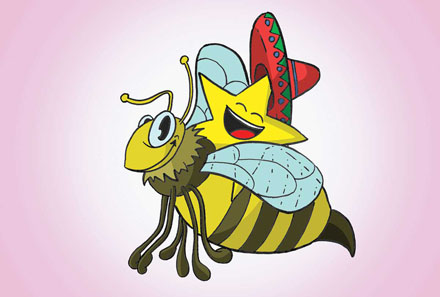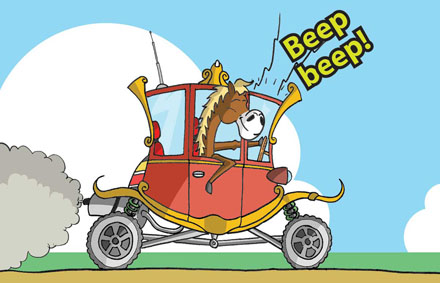Right now I’m going to teach you not only how to effectively memorize vocabulary using a combination of visual mnemonic techniques and spaced repetition, but much more importantly: how to learn foreign language vocabulary, that is how to take that step from having the word memorized and knowing its definition to actually learning how to use it properly. Specifically, you learn when, where, how, and with whom it’s appropriate to use it – this is way beyond just memorizing its definition, which is only a single (but important) part of learning new words in a language. It takes you to the same level of familiarity and competency with the word in question that native speakers have with it.
Memorization and study/learning techniques in general is something I’ve been fascinated by and learning about for years, nearly as long as I’ve been interested in foreign languages, and not always in relation to foreign languages (they’re good for so many things!). I’ve read many books on this subject and applied it to many different things over the years. Now,
obviously, given the nature of this site and the fact that I’m a language nerd, you can probably see where this is going: oh yes, I have all sorts of tricks for learning foreign language vocabulary and even grammar rules and syntax that I’m going to share with you now.
Today I’m just going to cover how to learn vocabulary (words and expressions) and I’m going to give you the most effective method I’ve come up with (that I currently use) in as short a time I can, so let’s go. Oh, and I’ll also throw in some additional tips and recommendations at the end for sites to check out and books to read if you’d like to learn more about this subject.
3 Simple Steps: Memorize, Review, Apply
Step 1: Memorize the Word
You do this using the substitute word technique coupled with visualizations (both taught below). This is a sort of temporary superglue used until we can properly and permanently bolt things into place. It’s very fast (compared to other memorization techniques like rote) and effective, however the downside is that it’s relatively slow on the recall, meaning that relying solely on this technique results in each word taking a second or two (or a few) to recall later on when you need it and obviously that won’t work when you’re speaking a language at full speed or listening to and trying to comprehend someone else speaking a language at full speed where you’ll need to recall several words per second.
These memory techniques have their uses, and those uses are extremely valuable when they’re part of an effective overall system, but they really won’t do the job on their own. Point is: this is going to save you a lot of time and effort in the beginning when you first learn a new word, it’ll quickly fix it in your short-to-medium-term memory so that you can permanently bolt it into place, so to speak, in your long-term memory via review and, most importantly, application (actually using the word or expression to communicate).
Step 2: Review
Using spaced repetition to review the word or concept you want to remember has been proven to be an extraordinarily effective way of memorizing it and keeping it memorized and fresh in your memory, ready for recall and use at any time you desire. This will allow you to learn thousands of vocabulary words, keep all of them fresh in your memory via carefully calculated review (the software I’m going to recommend takes care of that, yes it’s free), and only requires a few minutes per day of review (typically 5-30 minutes per day depending on how much you have to do).
Step 3: Apply
This is what really does it, this is what really gets us away from the tricks and techniques and having to work to keep something in our memory, and instead allows us to have it ready for immediate use at any time, able to be recalled in a split second on demand, and without having to work to keep it that way at all. In other words, it gets it to the same point as all the words in your native language that you already know – you can understand and use them in a split second and it’s not like you have to work at all to keep them in that state, now is it? Exactly. That’s what we’re aiming for here.
Not only does practice, actual use, completely take care of the whole “Can I remember it?” problem, but it also is what really makes the word learned rather than merely memorized. That is, by applying it, by actually using it to communicate with other people, you learn not just the meaning but also the appropriate context in which it should be used and how to do so: you learn when to use it, where to use it, and how to use it. You’ve truly “learned the word” at that point, you know it and can use it as well as a native speaker.
I’ll show you two different ways you can do this, both of which involve communicating with (one for writing with, one for speaking with) native speakers, and both of which are entirely free.
Learning vs. Memorization
Yes, we’re going to learn the word as well, as in not just what it means but also how and when to use it, but right now, this moment, at the very beginning when you’re first learning a new word in a foreign language: you need to immediately memorize the definition. That’s Step #1. That is the most important thing and the best possible jumping off point to actually learning it in my opinion.
We’re going to learn some of the most basic and effective memorization techniques there are, but I want to make their purpose clear: to burn the word into your memory almost instantaneously so that you can immediately get to work applying it thereby allowing you to avoid spending time trying to memorize it by rote or having to look it up and fiddle around with it in the future as you try to apply it. It’s to aid your practice and application of it, it’s to aid you in learning the word. It’s a crutch that you use only initially until you’ve actually learned the word such that you can recall it automatically in a split second without any effort, tricks, or techniques just as you can understand and recall the words of your native language as you speak or hear them. These techniques are to help you get to that point. No, you will not constantly have to use them every time you want to recall the word in the future, just the first few times until it’s fully cemented into your long-term memory. This stuff saves you time and effort, that’s all, it’s just a head-start, a useful short-cut (that works!). It helps you learn, it’s a part of the learning process, it isn’t learning itself.
So how do we do this…and who’s Harry Lorayne?
Harry Lorayne’s 4 Cardinal Rules for Memorization
Harry Lorayne is a well-known and respected author, magician, performer, and memory expert who has written numerous books on memory techniques over the years. I’ve read a lot of books about how to memorize this, that, and the other, tried all their techniques myself, and I take Harry’s stuff over everyone else’s and I don’t look back. He’s the man in this field.
His best-selling book on how to memorize things, and the one that I recommend the most if you want to learn more about this as well as the one I’m referencing for this article, is The Memory Book.
We’re going to be using a technique of his called “the substitute word technique”. This is where you memorize an abstract word – one you would have a hard time visualizing – by coming up with a word that sounds like or reminds you of the word in question and that can be pictured in your mind. A good example would be the Spanish word “ir”, which means “to go” and is pronounced like the English word “ear”: can you somehow visualize the concept of “going” in your mind in such a way that it’s associated with the Spanish word for it? Kind of difficult, isn’t it? “To go” is an abstract concept and therefore difficult to visualize…
How about…how about if we represent the Spanish word “ir” with an actual…giant…running…ear? How about that? How about now? Can you see that in your mind? Are you likely to forget it any time soon? No? That’s the point.
Imagine the ear about the size of a person, with legs, in running shorts…maybe with the full running regalia on: shorts, running shoes, headband, MP3 player and earbuds, everything…imagine it like that, and imagine it going on a run in the countryside.

Maybe, if you really want to hammer home that it’s got something to do with Spanish, you could have it wearing a shirt with the Spanish flag on it or singing Spanish music to itself (note the shorts in the picture above: they vaguely resemble the Spanish flag).
And there’s more than one way to skin a cat (or ear, as it were): alternatively, if it works better for you, you could imagine a pair of ears, several of them perhaps, playing…the board game Go! “Ir” (pronounced “ear”)…means “to go”…so a bunch of ears playing the board game Go…get it?

Yes, I know, I amaze myself sometimes.
Point is, anytime you hear the Spanish word “ir”, you’ll think of “go”, and any time you think “wait, how do you say ‘to go’ in Spanish?” you’ll think of “ir”. That’s how this works. Back to Harry Lorayne’s four rules…
Harry came up with a set of 4 simple rules concerning how to go about coming up with these visualizations that help you memorize whatever it is you want to memorize. These are extremely useful, pay attention:
1. Substitution – This is what we just learned, you simply substitute something that’s easier to remember for something harder to remember that you’re trying to learn. The concept of “going” is hard to visualize, an ear is not. You can see an ear, you can’t see “going”.
2. Out of Proportion – Was our ear regular-sized? As in, was it a normalish, at least, ear? No, it was huge, the size of a human, with legs, running, and dressed for the occasion to boot. Make things bigger or smaller than they would normally be.
3. Exaggeration – This means exaggeration in numbers, as in don’t just see one of whatever you’re trying to visualize, see dozens or thousands or millions. This is one we didn’t use but could have: you could’ve seen thousands of ears running down the street in a marathon or running across the African plains in a stampede like they’re a herd of antelope or something.
4. Action – Make them do stuff. This one’s really important. Was our ear just standing there, saying “I mean, ‘to go'” aloud, or holding a sign that said “To go – ir – it’s Spanish for ‘to go'”? No, it was running, moving, playing a board game (moving pieces, hopping up and down and/or yelling in excitement, etc.). Put action in your visualizations.
Note the overall goal here: to make the visualization memorable. Do whatever you have to in order to make that happen. It should be, for whatever reason (ridiculous, emotional or personal to you, scary, exciting, etc.), memorable, something not easily forgotten (like a giant running ear).
It doesn’t have to be perfect, and a few more examples
I used to insist that my substitute words be an almost perfect match for the word I was trying to memorize, e.g. if I was trying to memorize the Spanish word “estar”, which means “to be”, I would refuse to use the term “a star” to do so because the first sound, “a”, wasn’t the same sound as the first syllable in “estar”, it was “a-star” instead of “eh-star”. I’m no longer this anal retentive and have learned that it’s really unnecessary to be so. Listen carefully…
It only needs to be good enough to remind you of what you want to remember.
That is, it only needs to be able to remind you that the word you’re looking for is “estar”, and “a star” will do that, it’s plenty close enough. Now, I don’t know how exactly you could use the concept of “a star” to remind you that “estar” is the Spanish word meaning “to be”, perhaps picture a star doing something involving a bee (yeah, the insect kind, hell of a lot easier to visualize that than it is the concept of “to be”, isn’t it?), perhaps it’s riding a giant bee while wearing a Mexican sombrero…

…or fending off millions of them or it’s a Spanish matador, replete with uniform and cape, except instead of a bull it’s waving her red cape at…a bee (a huge one, of course! and it can’t fly! it charges the star! “Olé!” it yells, “Bzzzzz!” says the bee).

It doesn’t need to include every sound in the word, either. For example: “entregar” means “to deliver”, I can just see a giant gar (it’s a fish with a very distinctive appearance, see picture below) in a FedEx or UPS uniform delivering a package to the front door of my house (use your house, not just a house, make it distinctive and specific and therefore memorable), whereupon I fling open the door and say, in my most clichéd Pepe Lepeu French accent, “Entré, Monsieur Gar!”. See that fish below? Imagine it the size of a human, walking up to your door, whistling, dressed as a UPS driver and delivering a package to you, who upon opening the door say in a crappy French accent, “Entré!”.
“Gar”…”Entré!”…”entregar”…”to deliver”…got it?

Gosh that’s a…unique-looking fish, isn’t it?
Honestly, you could even leave out the “entre” part of “entregar” in your visualization, just stick with the gar-delivering-a-package bit, and it wouldn’t prevent it from working – this is an important point I want to make about this. It’s good enough to remind me of the word I’m looking for, and good enough is good enough…especially when time is of the essence as it is when you’ve got a lot of vocabulary words to memorize since you’re learning a whole new language so you can’t afford to spend more than a minute or so on each word, and ideally a lot less than that (shouldn’t take more than 5-10 seconds to come up with a solid visualization once you get some practice and master the technique).
Other times this isn’t even necessary (in fact this happens a lot, Spanish and English share lots of cognates) since the word is so close to the equivalent in English (or any other language you speak) that the English word will remind you of the foreign equivalent you’re trying to remember, e.g. the Spanish word for “supplier” is “proveedor” which is close enough to “purveyor” that I really don’t need to do anything else with it, that alone will remind me of “proveedor”. Another good example is one of two common Spanish words for “car”: “carro” (the other one is “coche” – “carro” is used more in South America whereas “coche” is used in Mexico and most of Central America). Do you really need a mnemonic to help you remember that “carro” means car?
To remember that “coche” (pronounced “coach-ay”) is the other word that means “car” just involve either a horse-drawn type coach or a sports team type of coach (when possible, use something personal to you: pick a coach you actually know, like one from high school). You could see a horse coach that’s been turned into a car via the installation of all the various necessary mechanics being driven along (perhaps…by a horse?) spewing exhaust fumes out the back and going “Beep beep!” with its horn as it goes by you…

…or you could see a car that looks like your high school coach driving down the road (it waves at you!), or you could see your high school coach running down the road on all fours at 70 MPH like a car and he makes a racing car style “NNNEEEOOOOWWW!” sound as he goes past.
This is what I’m talking about: animated, action, color, ridiculous, exaggeration, funny, crazy, scary, emotional, personal, huge/tiny…memorable.
Get it?
Step 2: Review
This is what’s going to allow you to have a vocabulary of thousands of foreign words that you never forget, can use/recognize on demand, and all while only spending a few minutes per day reviewing them (I’d guesstimate 15-30mins for 3000-7000 words, just to make the point). How?
Because only those words that most need to be reviewed will come up for review that day, meaning that you’ll only actually review a few dozen cards, most of which you will already know. They will be chosen based on based on how new they are, how often they’ve been reviewed before, how often you’ve gotten them right when you do review them, and how long it takes you to answer when you’re shown them
How does this magic take place? Anki (this link will take you to their site where you can download it for free), that’s how. In a word, that’s it: just use Anki (this link will take you to an article I wrote on it telling you exactly why it’s so good and how to use it including a demo video I made which I’ve also embedded below). It uses an algorithm to calculate all the relevant data I previously mentioned and determine which cards you need to see that day. It’s basically a very sophisticated electronic flashcard system or Spaced Repetition System (aka ‘SRS’).
So what do you actually do?
Simple: as you’re learning new words, have Anki open and put them in it along with the definition and, I recommend, the context in which you originally learned them as an example sentence. That is, the front of the card would be the English definition and the back of the card would be the foreign word in question (or medical/legal term or whatever it is you’re learning), and of course you can do a second card in reverse (Spanish on front, English definition on back) if you wish though I don’t think that’s necessary since having the English definition on the front forces you to recall the word, and recall is a much more demanding test of memory so if you can recall it you can generally recognize it as well, you don’t need to practice both.
Here’s a video of me demonstrating this, how I use Anki, with a movie that I’m learning Spanish from (I have a whole method on how to do this, how to learn Spanish from TV shows, movies, music, and the like called The Telenovela Method if you’re interested):
That is some awesome hair, isn’t it?
Step 3: Apply
This is the real winning move right here, this is what makes you truly fluent in a language: using it with native speakers.
Hang on, don’t get scared, we’ve got a couple different ways we can go about this, no you don’t have to actually speak to someone if you don’t want to (though that is one way and an excellent one at that), there are written means I’ll cover as well. Now, to emphasize how important this is and explain why, I’m going to just quote what I’ve said elsewhere:
You’ve learned some new words and phrases and grammar, you’ve learned what they mean, but…you have not learned how to use them, that is you have not learned them such that you can correctly use them in a conversation with a native speaker. It does not matter how well you’ve memorized the definitions or grammar rules or even how many different contexts you’ve seen/heard them used in (though it helps, and note my emphasis on “seen/heard”, I emphasize the passive nature of that action).
The only way to learn this is to learn by doing, the only way to learn how to use what you’ve learned so far is to use it, the only way to learn how to speak properly is to speak improperly to a native speaker, who will point out your errors and tell you the right way to do it, and that is when and how you will learn to do it correctly. You will learn by making mistakes as fast as you can: the more errors you expose to the light, the blinding light of critical examination, and the faster you do so, the better you will get at actually communicating (speaking and writing) with native speakers, which is what I know the great majority of you are most interested in, and the faster you shall do so.
– The preceding two paragraphs are taken verbatim from my book, The Telenovela Method.
So how, specifically, can we go about doing this?
Technique #1: Lang-8
Lang-8 (official website) is essentially a high-tech penpal system, a sort of written online language exchange where you post things written in the language you want to learn and native speakers correct it for you (because they get points for it, essentially, that they can then use to get native speakers of the language they’re learning to correct their writings for them). I highly recommend you refer to the full article I wrote about Lang-8 just recently: How to Practice Writing a Foreign Language (and get native speakers to review and correct it for you for free!): Lang-8, but in summary:
You make what are called “journal entries” that can be about absolutely anything you want (I like to make up goofy stories, it’s fun and people enjoy correcting them): fiction, something about your day, something that happened in your past, commentary about current events (pick a news story and talk about it, simple), whatever you want. Then, you publish it and wait for a native speaker to correct it (won’t take long, typically 15-30 minutes for popular languages like Spanish, French, English, etc.). Those corrections will look something like this:

That’s from a story I wrote a couple years ago. The red and blue ink and strike-through you see are corrections made by a native speaker to my Spanish, then you’ll notice he’s left a comment explaining his corrections and giving suggestions as to how I can make it sound better. Isn’t that lovely?
Also, note that when I write these entries on Lang-8 I always do so with the purpose of applying/testing some new vocabulary I’ve just learned, in this case it was the word “Aún”, which I had learned from Pan’s Labyrinth (great movie, highly recommended for learning Spanish), as well as wanting to figure out how to say the expression “to have heard”, like “to have heard people saying”, so I figured I would just take my best shot at how I thought one might say that in Spanish and wait to see what the native speakers would say: it worked!
I tried “había oido hablar de que…” (roughly “she had heard talk of…”) and that was corrected to “había oído decir que” (something like “she had heard it said that…”), so that’s how you express that in Spanish (plus he corrected my misspelling of “oído”: the “i” should have an accent)! Cool! See how quickly and easily I learned that? See how effective that is?
Technique #2: Language Exchanges
Feeling brave? Ready to talk face-to-face in real time with a native speaker and show them just how well you can butcher, I mean speak, their language?
A language exchange is another excellent way to apply Spanish that you’ve just learned. For those unfamiliar I recommend reading my article about why they’re so important and how to fully utilize them but in short the way they work is that you first sign up on a language exchange site (I recommend iTalki – that’s their site and here’s my review of them), which are generally free to use (all the good ones are in my experience), and then use it to meet native speakers who are also learning your native language, talk to them via Skype, do half the exchange in the language you’re learning and half the exchange in the language they’re learning (your native language), with each one correcting the other in exchange, hence the term “language exchange”.
So, for example, if you’re a native English speaker learning Spanish (the most likely scenario given my audience), then you would find native Spanish speakers learning English via the language exchange site, set up a time to talk via Skype, and then when you do so you would spend half the session in Spanish with them helping you and half the session in English with you helping them. Typical times are 15 minutes in one language and 15 minutes in the other. Simple, it doesn’t cost anything, and it’s probably the single most effective thing you can do to learn the language.
Of course, what I’m saying you should do here is use your newly learned vocabulary during said language exchange on Skype and the native speaker will help you do so and correct any mistakes you make – you learn how to properly use that vocabulary by using it with a native speaker!
*Super useful tip!
What I recommend you do is either write up something to say ahead of time that incorporates the vocabulary or at least have it in list format in front of you during the exchange. That is, have a text file or something similar open during your Skype session with them that contains either a list of words/expressions you’re going to try to use or a list of things to say (sentences/paragraphs) that contain the those words/expressions.
You could also obviously do the above in real life with any native speakers who are friends or relatives you have, or if there’s some sort of local language exchange program in your area (check Meetup.com) then you could do it that way, and that would be fantastic.

Oh, hey, couple quick questions before we wrap it up: how do you say “to go” in Spanish, what’s the verb? How about “to be”? Maybe you can recall how to say “to deliver” while you’re at it?
😉
Conclusion and a related free site and some books I think you may be interested in…
Whew! That was a long one. I don’t do these (looong posts) too often, they take forever in writing, resource location, and editing, but when I do they tend to be popular (that one’s been just killing it in terms of traffic for years) so it’s definitely something I’ll keep doing regularly. I really hope that helped you, please do leave any criticisms or suggestions in the comments, and stick around for a second for a couple of additional resources I really think will be of interest to you.
I’ve recently completed a course on Coursera, which is a site that offers free university level courses in just about everything (can’t recommend it highly enough, so much you can learn on there and it’s all free), called Learning How to Learn with Professor Barbara Oakley, PhD. I highly recommend you keep an eye out for that course (it’s finished now) and sign up for it in the future when it becomes available again (just checked, the next class is scheduled to start January 2nd of 2015). Additionally, the course is based very closely on a book she wrote which I also highly recommend called A Mind for Numbers which, despite its title, is actually a book about general learning with only a slight emphasis on science and math (and requires absolutely no mathematical or scientific background, by the way).
I learned to speak conversational Spanish in six months using TV shows, movies, and even comics: I then wrote a book on how you can, too
I have a whole method and a book I wrote about it called The Telenovela Method where I teach you how to learn Spanish from popular media like TV shows, movies, music, books, etc. that you can all find online for free. It was the #1 new release in the Spanish Language Instruction section on Amazon for nearly a month after it came out and currently has 17 reviews there with a 4.9/5 stars average. It's available for $7.99-$9.99 for the e-book version depending on who you buy it from (Kindle version on Amazon is now $7.99) and $16.99 for the paperback (occasionally a bit cheaper, again, depending on who you buy it from).
It's currently available in both e-book and paperback from:
Cheers,
Andrew







